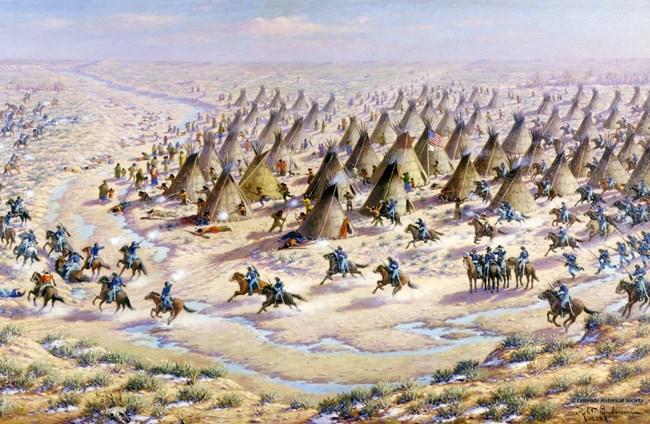
- Details
- By Native News Online Staff
THIS DAY IN HISTORY - On November 29, 1864, seven hundred members of the Colorado Territory militia embarked on an attack of Cheyenne and Arapaho Indian villages. The militia was led by U.S. Army Col. John Chivington, a Methodist preacher, as well as a freemason. After a night of heavy drinking by the soldiers, Chivington ordered the massacre of the Indians. Over two-thirds of the slaughtered and maimed were women and children. This savage atrocity has been known as the Sand Creek Massacre ever since.
While the exact number of American Indians killed that day varies, award-winning historian Alan Brinkley wrote that 133 Indians were killed, 105 of whom were women and children.
For years, the United States had been engaged in conflict with several Indian tribes over territory. The Treaty of Fort Laramie in 1851 had given the Indians extensive territory, but the Pikes Peak gold rush in 1858 and other factors had persuaded the U.S. to renegotiate the terms of the treaty. In 1861, the Treaty of Fort Wise was signed by Southern Cheyenne and Arapaho chiefs. The treaty took from the Indians much of the land given to them by the earlier treaty, reducing the size of their reservation land to about 1/13th of the original amount.
Although the peace seeking chiefs signed the treaty to ensure the safety of their people, not all of the tribes were happy with the decision. In particular, a group of Indians known as the Dog Soldiers, made up of Cheyenne and Lakota, were vehemently opposed to having white settlers on what the Indians still referred to as their land.
In 1864, a group of Civil War soldiers under Chivington, with the blessing of Colorado governor John Evans, began to attack several Cheyenne camps in Colorado. Another attack on Cheyenne camps occurred in Kansas by forces under the command of Lieutenant George S. Eayre. The Cheyenne retaliated for the attack, furthering the aggression of the U.S. forces.
In an attempt to maintain peace, two chiefs, Black Kettle and White Antelope, tried to establish a truce. They were advised to camp near Fort Lyon in Colorado and fly an American flag over their camp to establish themselves as friendly.
More Stories Like This
Biden Nominates Salish & Kootenai Tribal Attorney Danna Jackson for Federal BenchA Conversation With Lt. Gov. Peggy Flanagan: What We Can Celebrate Around the State
Return to the Heart Foundation Gives 44 Micro-Grants to Native Women Leaders
Indigenous Journalists Association President Addresses Members of the UNPFII
Inter-Tribal Council Passes Resolution Urging FCC to Establish Specific Event Code for Missing and Endangered Persons
Native Perspective. Native Voices. Native News.
We launched Native News Online because the mainstream media often overlooks news that is important is Native people. We believe that everyone in Indian Country deserves equal access to news and commentary pertaining to them, their relatives and their communities. That's why the story you’ve just finished was free — and we want to keep it that way, for all readers. We hope you'll consider making a donation to support our efforts so that we can continue publishing more stories that make a difference to Native people, whether they live on or off the reservation. Your donation will help us keep producing quality journalism and elevating Indigenous voices. Any contribution of any amount — big or small — gives us a better, stronger future and allows us to remain a force for change. Donate to Native News Online today and support independent Indigenous-centered journalism. Thank you.

